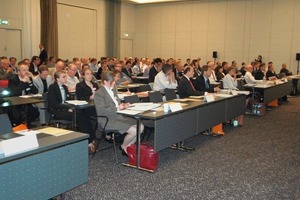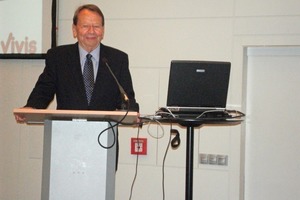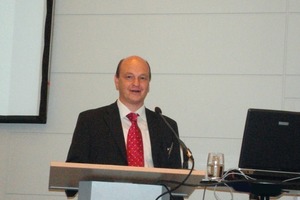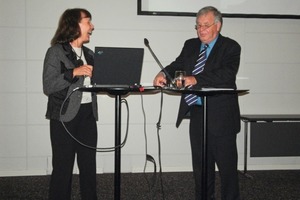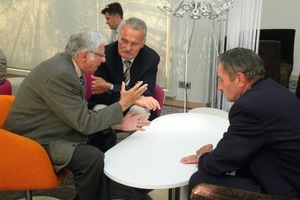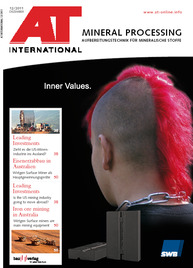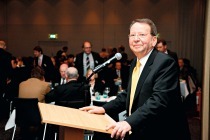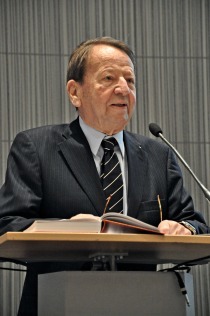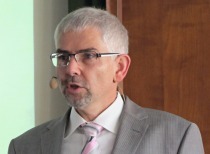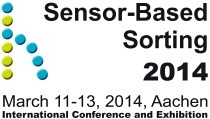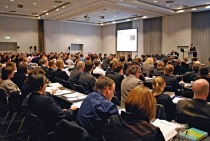Strategy of recovering raw materials from waste streams
On 29 and 30 June 2011 experts from recycling companies, from machine and plant engineering, planning offices, universities, administration, associations and other institutions met for the 4th time in Berlin to discuss new aspects with regard to securing a future supply of raw materials by means of waste recycling. The Berlin Conference is unique in the excellent way it covers technological, economics, political and legal aspects of recycling at a single event. These are all specialist fields connected with the wide field of recycling management. The more than 200 participants (Fig. 1) were offered a varied and interesting programme, mainly focussing on the recycling industry.
The organizer was again the publishing house TK Verlag Nietwerder. The conference was scientifically directed in the proven manner by Prof. Dr.-Ing. habil. Dr. h. c. K. J. Thomé-Kozmiensky working alongside Prof. Dr.-Ing. D. Goldmann, Institute of Preparation, Landfill Technology and Geomechanics of Clausthal Technical University, who did it in their proven manner. They were supported by a high-calibre scientific advisory board.
Supplying our economy with raw materials is becoming a more and more urgent question, taking into account the development of prices, but also the availability of primary raw materials and data concerning workable deposits in the world. Above all, in countries lacking in raw materials like Germany, supreme efforts must be made to look for new ways to ensure the supply of raw materials, not least utilizing the potential of recycling waste. Consequently, it is logical that strategic aspects of recovering resources from waste streams were the main topic of the conference, taking up the entire first day as the plenary session.
In his inaugural address Prof. Dr. Thomé-Kozmiensky (Fig. 2) discussed the challenges resulting from this topic both for politics and legislation, but also for the manufacturing and recycling industries including research and, last but not least, for the consumers.
In line with the profile of AT recovery only selected lectures that deal with questions concerning waste processing and recycling will be detailed in the following. Prof. Dr. Goldmann (Fig. 3), Clausthal Technical University, referred to the necessities and uncertainties of securing resources in his lecture entitled “Development and implementation of complex recycling systems under changed general conditions”. Based on the development of the world’s population, raw material consumption and the amount of waste produced, he concluded on what has to be done, taking into account the existing political and economic strategies as well as the general legal conditions to meet the technical and logistic requirements of long-term recycling planning. The increasing complexity of the products, multi-material recycling approaches enabling a stronger catenation of recovery systems or the early recycling of crucial raw materials were only a few aspects broached by the lecturer.
R. Kaiser from the German Ministry of the Environment, Nature Conservation and Nuclear Safety (BMU) introduced “ProgRess – the German resource efficiency program 2011”. The goal is for Germany to become the most resource-efficient economy, with sustainability as a principle of the German policy. In October 2010 the Federal German cabinet passed a resolution regarding Germany’s raw material strategy. The BMU was instructed to prepare a German resource efficiency program, which is to be approved by the cabinet in December 2011 so that it can be presented as a contribution to the UN Conference on Sustainable Development Rio+20 (in June 2012).
The old master of waste and recycling management, Prof. Dr. Thomé-Kozmiensky, discussed the captivating topic “Recycling in the field of tension between disposal, securing raw materials and power supply”. He clearly characterized the importance of waste management and classified thermal waste treatment as a possible preliminary stage for further recycling (extraction of metals from dusts). The speaker described the path from the discovery of waste as a “raw material store” for the conservation of natural resources up to the polished methods of extracting valuable raw materials available today. However, he also outlined the limits of waste utilization (ecology, hygiene, logistics, technology, law, standards) and underlined that recycling has to be complemented by thermal utilization.
Dr. Doris Schüler from the Darmstadt-based Öko-Institut explained a “Sustainable economy of rare earths for Europe”. Based on reflections regarding reserves, current production, planned production facilities, environmental risks, international trade, development of supply and demand, four columns of a sustainable rare earth economy in Europe (efficiency, substitution, sustainability and recycling) as well as the necessity of a European recycling system were described.
Other lectures dealt with the critical analysis of recycling as a means against raw material risks and of the possible securing raw materials as a challenge for Germany as an industrial base (Dr. H. Bardt, Institute of the German Economy, Cologne), with the theoretical and usable potential of valuable materials in residual waste (Prof. Dr. W. Rommel; Dipl.-Ing. M. Hertel, bifa Umweltinstitut, Augsburg) or with the topic ‘recycling bin and commercial collection’, which should be considered an instrument of recycling.
The second day of the conference consisted of three parallel sessions:
• Strategic raw materials in and from waste streams
• Waste mass flows
• Mineral processing - mechanical processes and machines
Within the framework of this report, it is only possible to name and comment on only a few of the many interesting and informative contributions. It goes without saying that mineral processing respectively recycling technology is given preference.
Strategic raw materials are those materials that are needed for high-tech products and future technologies without being clearly defined. This group comprises, for instance, Li, Ga, In, Sc, Ge, Ne, Pt, Ag, Ta Nb, Se, Rh as well as the rare earths (e.g. La, Pr, Nd, Eu, Y, Tb, Dy), but also Cu. Some lectures in this section dealt with the recovery of raw materials from electrical and electronic equipment (Dipl.-Ing. A. Habel from the Bonn-based Federal Association for Secondary Raw Materials and Disposal, bvse; Prof. Dr. Vera Susanne Rotter, Berlin Technical University; Dipl.-Geogr. (graduated geographer) A. Manhart from the Freiburg-based Öko-Institut).
Dr. E. Schüler-Hainsch, Daimler AG, Berlin, talked about “Raw materials for electric mobility” and Dipl.-Ing. T. Elwert from Clausthal Technical University lectured on the “Recovery of lithium from lithium ion traction batteries”. M. Sc. Stella Konietzko, Volkswagen AG Wolfsburg, lectured on the “Strategic resource planning based on waste streams demonstrated based on the example of Li”. New findings could also be presented for the recycling of magnesium (Dr. habil. Ch. Scharf, Clausthal Technical University), of copper (Dipl.-Ing. Ch. Kawohl, Aurubis AG, Lünen) and of aluminium (Prof. Dr. G. Rombach, Hydro Aluminium Deutschland GmbH, Bonn). Interesting aspects of recycling were dealt with by Dr. G. Schetter and Dipl.-Ing. Ruppmann from Verbrennungsanlagen GmbH, Stuttgart, (“Thermal treatment of production residues containing noble metals“) and by Dr. H. Pflaum, from the Oberhausen-based Fraunhofer Institute UMSICHT (“Recycling for environmental protection – comparison of CO2 emissions when using primary and secondary raw materials”).
The main topics of this section, in addition to the “Recycling technology for emissions trading” (graduated commercial engineer B. Gerstmayr, Bifa Umweltinstitut, Augsburg), were questions concerning the recycling bin as well as legal and technical aspects of the recovery of mineral raw materials. These are a few examples:
• “Raw materials and technologies for building materials recycling” (Prof. Dr. habil Anette Müller, Weimar Bauhaus University)
• “Recovery of non-ferrous metals by dry slag removal” (Dr. R. Koralewska, Martin GmbH for the Environment and Energy Technology, Munich)
• “Utilization of slags from steel mills” (Dr. Th. Merkel, Industrial Association for Slags from Steel Mills, Duisburg)
• “Utilization of plastic waste as raw materials for the production of calcium carbide” Prof. Dr. habil. K. Thomé-Kozmiensky)
Many participants were interested in the promising programme of the third section. Mineral processing is the key to the recycling of waste. And the conference participants were not disappointed. In addition to highly developed recycling and separation technologies, such as sensor and X-ray technologies, they also rediscovered old equipment that was used already in mining, e.g. jig washers or floatation machines, which played a role in some lectures.
First Dr. habil. H. Westholm, trend:research GmbH, Bremen, lectured on the market for sorting equipment and said that all member countries have to invest in sorting installations to comply with the EU’s legal directives (waste framework directive, landfill and packaging directives). In particular this refers to those countries where still 90 % of the waste is still deposited (United Kingdom, Italy, Spain, the Czech Republic). There is therefore great potential for development and many machine and plant engineering companies consider it an opportunity. The demand for advanced, fully automatic sorting plants will be particularly great. However, high competition intensity will lead to an extraordinary price war that will be further aggravated by the cut-price offers from Asia. It was outlined that the trend for sorting plants for valuable materials is turning away from the use of many small plants in favour of a few large plants. In Germany the latter have specialized in certain secondary raw materials. In England the observed trend is towards sorting quantity rather than high sorting quality.
The Meppen-Hüntel-based Sutco Recycling Technik GmbH & Co. KG has already adapted to this development as the lecture of M. Ludden “International challenges of a medium-sized business as plant engineering company for waste” showed. Thanks to the acquisition of companies, branches could be established in Poland and England. Thus, the company has been able to gain a lot of experience as regards equipment and system supplies as well as plant engineering, utilizing its entire know-how. Problems and difficulties associated with internationalization were outlined.
Dr. A. Weh, selFrag AG, Kerzers (CH), and Dipl.-Ing. G. Schippers, NUGA AG Kunst-stoffmühlen, Balgach (CH), described concrete treatment processes in their lectures “Comminution and breaking up of waste streams by means of pulsed high-voltage technology” and “Plastic comminution with reduced energy using CentriCut cutting mills” respectively. SelFrag is the first commercial supplier of processing plants using pulsed high-voltage technology. By means of selective fragmentation along the material boundaries, a wide range of solids can be disintegrated (mono-fraction liberation). This is a contactless and dust-free process with only limited contamination, which can be applied for almost all relevant materials. With reference to many examples, the lecturer showed the possibilities that the process offers for recycling but also in the manufacturing industry and in mining, for example the recycling of combustion slags, concrete, electronic scrap or carbon fibres. The process is particularly attractive for high-purity applications, e.g. the production of highly pure quartz or solar silicon. The goal is to further industrialize the plants from currently 0.2-1 t/a up to 10-100 t/a or 35 000 t, respectively, for the recycling of electronic scrap and concrete.
Dipl.-Ing. G. Schippers presented the cutting mill CentriCut, with which a considerable amount of energy can be saved as opposed to other mills. The reduction of energy consumption was substantiated with figures from a case study.
Dipl.-Ing. M. Gursch from the Reinbeck-based Amandus Kahl GmbH & Co. KG lectured on the “Comminution by means of matrix presses”. He demonstrated with various examples of use (wet and dry wood, pre-shredded used tyres, fibrous products, biomass) how a flat matrix press can be used as comminution machine. To enable operation as a comminution machine, a short press duct is needed as opposed to the use as pelletizing machine (long press duct).
Again and again, the extraction of metals plays a key role in recycling. As regards scrap preparation, amongst other things, the handling and further processing of chips for re-use is associated with various complex challenges. This was dealt with in the lecture “State of the art in the briquetting of metallic chips from metal processing” by Dr. A. Schmid and Prof. Dr. H. Flachberger, Leoben University of Mining and Technology (A), as well as F. Duspiva, ATM Recyclingsystems GmbH. This lecture included practice-relevant examples as well as reflections on the value of chips, chip condition and characterization as well as theoretical reflections on the briquetting process. It also discussed systematic investigations during briquetting and the optimization of the press configuration.
Five lectures dealt with the important field of classification and sorting. Dipl.-Ing. M. Riggenmann, TrennSo-Technik Trenn- und Sortiertechnik GmbH, Weissenhorn, talked about the versatile use of separators in his lecture “Air separation as a prerequisite for a more effective separation of waste streams” and demonstrated it with the examples of domestic waste, electronic scrap and shredder light fraction. Dipl.-Ing. G. Kreindl, Leoben University of Mining and Technology (A) and Dipl.-Ing. H. Curtis, Saubermacher Dienstleistungen AG, Feldkirchen (CH), lectured on the “Technical possibilities of near-infrared sorting of mixed industrial and commercial waste”. The lecture of Dipl.-Ing. Angelica Feierabend (Fig. 4), LLA Instruments GmbH, Berlin, (“Sensor-based near-infrared sorting for recycling and processing of mineral raw materials“) focused on measurement technology and industrial quality control. She presented devices developed in her company (line spectrometer and hyperspectral spectrometer) and described some typical applications (plastic and paper identification and sorting, chlorine analysis of materials for substitute fuels, analytical quality control in the rock processing industry). The relatively new application of the NIR technology to inorganic materials is based on their different water absorptivity (adsorption and absorption water as well as water of crystallization).
A lecture on “Vibrating screens for recycling plants” (Dr. W. Heinrich, Haver & Boecker OHG, Oelde) and another one on the “Possibilities of the density-based separation of plastic mixtures” (Bachelor of Commerce H. Guschwall, SICON GmbH, Hilchenbach) showed impressively how the experts successfully deal with the separation technology and its specification for the corresponding application.
The organizers again succeeded in informing and confronting the conference participants about and with interesting innovations in the field of recycling by specifying selected topics of current interest and by selecting mostly internationally renowned lecturers. Securing resources is the top priority. This applies to technology and industry as well as to politics and legislation. Like last year, this year’s conference also showed that recycling management always plays an important role with regard to accessing and developing raw material resources. In the field of secondary raw materials, the further development of machines and devices is opening up a wide array of potential applications, which will be aligned to both mass products and speciality products, such as rare earths and noble metals.
The already traditional Berlin Recycling and Raw Material Conference again proved a platform for all those interested in the subject. The participants had ample opportunity to discuss, to establish new contacts and to deepen existing ones (Fig. 5).
Most of the lectures of the conference programme are included in “Recycling und Rohstoffe” volume 4, TK Verlag Karl Thomé-Kozmiensky, Neuruppin 2009, ISBN 978-3-935317-67-2.

